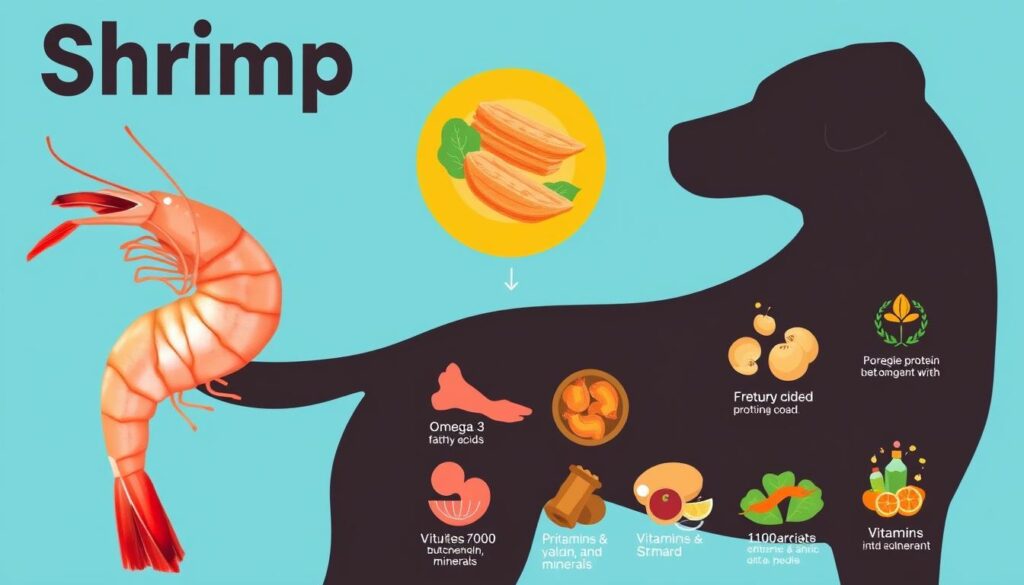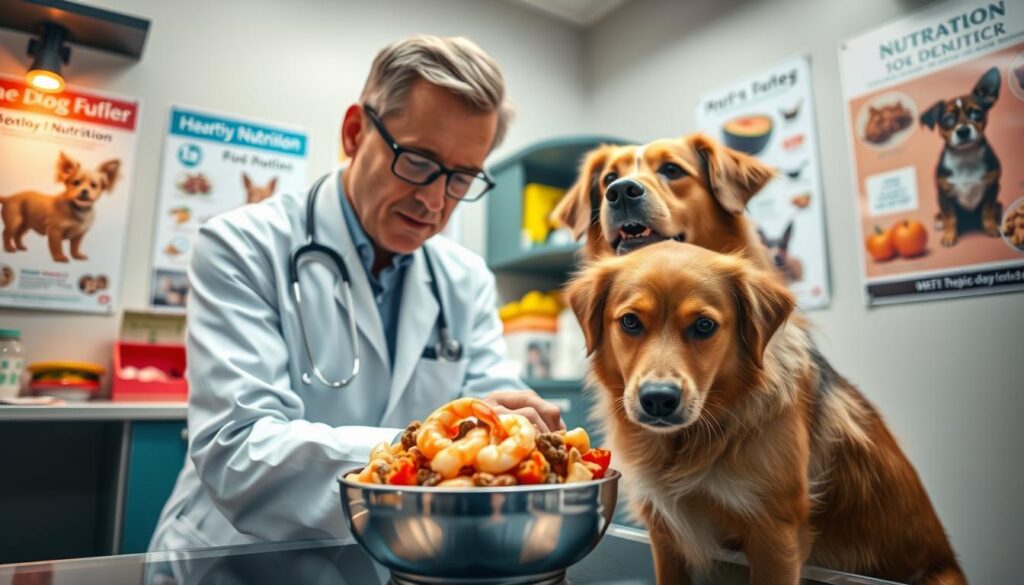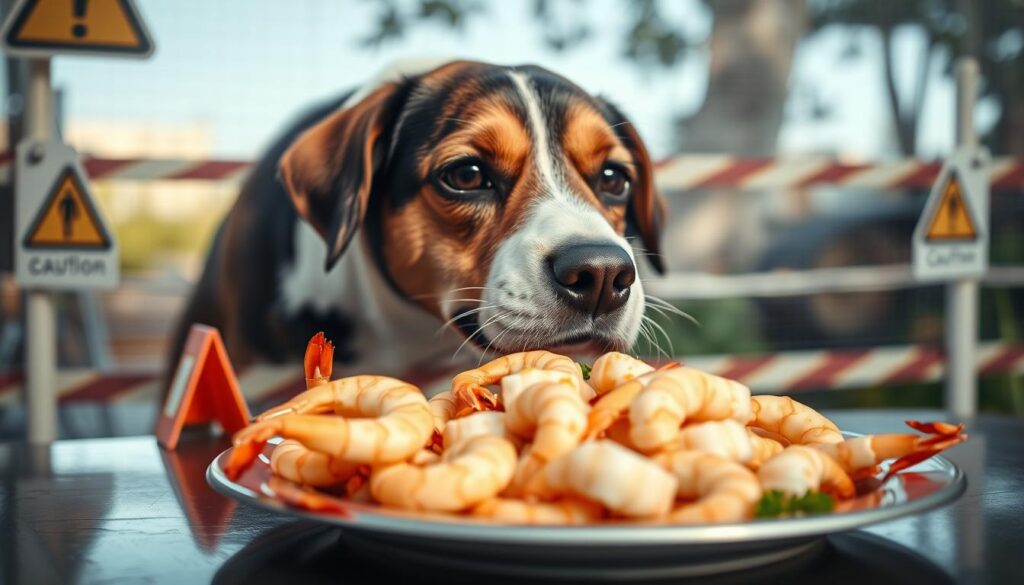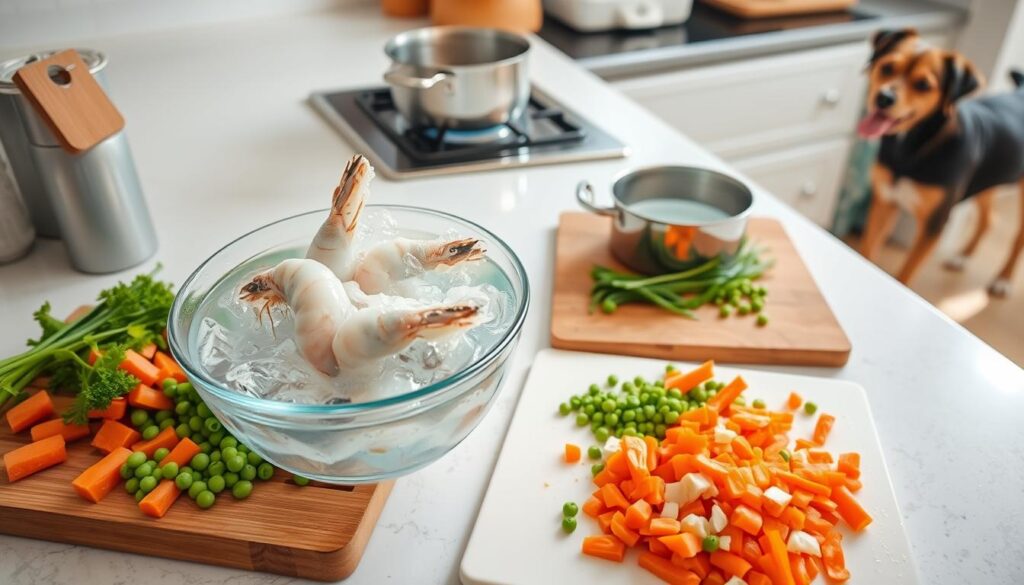Table of Contents
- Understanding Shrimp as a Food Option for Dogs
- Can Dogs Have Shrimp? A Veterinary Perspective
- Health Benefits of Feeding Shrimp to Dogs
- Potential Risks and Safety Concerns
- How to Properly Prepare Shrimp for Dogs
- Raw vs. Cooked Shrimp: What’s Safe for Dogs?
- Signs of Shrimp Allergies in Dogs
- Best Practices for Introducing Shrimp to Your Dog’s Diet
- Different Types of Shrimp and Their Suitability for Dogs
- What to Do If Your Dog Eats Shrimp Shells or Tails
- Understanding Serving Sizes and Frequency
- Conclusion
- FAQ
Ever thought about giving your dog a taste of your seafood? The idea of dogs eating shrimp is more complicated than it seems. Pet owners often struggle between sharing their meals and keeping their dogs safe and healthy.
Is shrimp safe for dogs? The answer is not a simple yes or no. Shrimp can be good for dogs, but there are important things to know before giving it to them.
This guide will explore the world of dogs and shrimp. We’ll look at the good and the bad. You’ll learn everything you need to know before giving shrimp to your dog.
Key Takeaways
- Shrimp can be a protein-rich treat for dogs when prepared correctly
- Proper cooking and preparation are critical for dog safety
- Always consult with a veterinarian before introducing new foods
- Moderation is key when feeding shrimp to dogs
- Watch for potential allergic reactions
Understanding Shrimp as a Food Option for Dogs
Dog owners are looking for new ways to improve their pets’ diets. Shrimp is becoming a popular choice because it’s healthy when cooked right.

Experts say shrimp is a great protein for dogs. It’s packed with nutrients and is a good choice for those wanting to mix up their dog’s food.
Nutritional Profile of Shrimp
Shrimp is good for dogs because it has:
- High-quality protein for muscle development
- Low-calorie meat alternative
- Rich in omega-3 fatty acids
- Contains important minerals like selenium and phosphorus
Why Pet Owners Consider Shrimp
| Nutritional Benefit | Impact on Dog’s Health |
|---|---|
| Lean Protein | Supports muscle growth and repair |
| Omega-3 Fatty Acids | Promotes healthy skin and coat |
| Selenium | Boosts immune system function |
Common Concerns About Feeding Shrimp
Shrimp is good for dogs, but there are things to watch out for. Potential risks include allergic reactions, cholesterol content, and proper preparation methods. Always talk to a vet before trying new foods.
“Moderation and proper preparation are key when adding shrimp to a dog’s nutritional plan.” – Veterinary Nutrition Specialist
Can Dogs Have Shrimp? A Veterinary Perspective

Veterinary experts have looked into whether dogs can eat shrimp. They agree that shrimp can be a safe treat for dogs sometimes. But, it must be prepared right and given in small amounts.
“Shrimp can provide valuable protein and nutrients to a dog’s diet, but careful preparation is key,” says Dr. Sarah Mitchell, veterinary nutrition specialist.
Before giving shrimp to dogs, consider these important points:
- Ensure shrimp is fully cooked
- Remove shells and tails completely
- Serve in small, bite-sized portions
- Monitor for any allergic reactions
When thinking about giving shrimp to dogs, start with a little. Dogs with health issues or sensitive stomachs should talk to their vet first.
The good things about shrimp for dogs include:
- Lean protein source
- Rich in essential minerals
- Low-calorie treat option
Veterinary guidance emphasizes that individual dog health varies, making personalized dietary advice crucial.
Health Benefits of Feeding Shrimp to Dogs
Shrimp can be a great addition to your dog’s diet. It offers many health benefits when given in the right way. Knowing the nutritional value of shrimp can help you make better choices for your dog.

Dogs can benefit a lot from eating shrimp in small amounts. Here are the main health benefits of shrimp for dogs:
Protein Powerhouse for Muscle Development
Shrimp is a top-notch protein source for dogs. It helps with:
- Muscle growth and repair
- Healthy tissue maintenance
- Strong immune system function
Omega-3 Fatty Acids for Whole-Body Wellness
The omega-3 fatty acids in shrimp are good for dogs in many ways. They help with:
- Reducing inflammation
- Promoting healthy skin and coat
- Supporting joint mobility
Essential Minerals and Vitamins
Shrimp is packed with important nutrients for dogs. It includes:
- Selenium: Supports metabolic function
- Vitamin B12: Enhances nervous system health
- Phosphorus: Strengthens bones and teeth
“Shrimp can be a nutritious treat when given in moderation and prepared correctly.” – Veterinary Nutrition Experts
While shrimp is very beneficial, always talk to your vet before adding it to your dog’s diet. It’s important to prepare it right and give the right amount for your dog to enjoy these benefits safely.
Potential Risks and Safety Concerns
It’s important to know if shrimp is safe for dogs. Shrimp can be a good treat, but there are safety issues to think about. Pet owners need to be careful when giving shrimp to their dogs.

Is shrimp safe for dogs? The answer is not simple. Dogs can face several dangers when eating shrimp:
- Choking hazards from shells and tails
- Potential allergic reactions
- Risk of foodborne illnesses
- Digestive system complications
Shrimp and dog allergies are a big worry for pet owners. Some dogs might have allergic reactions to shrimp. These can include:
- Skin irritation
- Digestive upset
- Respiratory difficulties
- Swelling around the face or mouth
“Always monitor your dog closely when introducing any new food, especially seafood.” – Veterinary Nutrition Expert
Raw or not well-prepared shrimp can have harmful bacteria. Bacteria like Vibrio and Salmonella can make dogs very sick. They can cause serious stomach problems and food poisoning.
Pet owners with dogs that have sensitive stomachs or allergies should be extra careful. It’s a good idea to talk to a vet before giving shrimp to your dog. This helps keep your pet safe and healthy.
How to Properly Prepare Shrimp for Dogs
Adding shrimp as a treat for your dog needs careful steps to keep them safe. It’s important to know how to prepare cooked shrimp for your pet.

Dogs can enjoy shrimp treats if they are prepared right. It’s all about following a safe process to avoid health risks.
Cleaning and Deveining Shrimp
- Remove the shell completely
- Eliminate the dark digestive tract (black line)
- Rinse thoroughly under cold water
- Pat dry with clean paper towels
Cooking Methods
Cooking shrimp right is key. Raw shrimp can have bacteria that might upset your dog’s stomach.
- Boiling: Best method for plain preparation
- Steaming: Keeps nutrients without extra oils
- Baking: Uses no extra fat
Portion Size Guidelines
| Dog Size | Recommended Shrimp Portion |
|---|---|
| Small Dogs (under 20 lbs) | 1-2 small shrimp |
| Medium Dogs (20-50 lbs) | 2-3 medium shrimp |
| Large Dogs (over 50 lbs) | 3-4 large shrimp |
“Always introduce new foods gradually and monitor your dog for any adverse reactions.” – Veterinary Nutrition Experts
When making shrimp treats, make sure they are plain and cooked well. Don’t use butter, salt, or spices that could be bad for your pet.
Raw vs. Cooked Shrimp: What’s Safe for Dogs?

Pet owners often wonder about feeding shrimp to their dogs. Veterinarians strongly advise against giving raw shrimp to dogs. Raw shrimp can be harmful because of bacteria and parasites that can upset your dog’s stomach.
Cooking shrimp makes it safer for dogs. But, it must be cooked right. Cooked shrimp is a good protein source for dogs if it’s prepared correctly.
- Raw shrimp risks:
- Bacterial contamination
- Potential parasites
- Risk of foodborne illness
- Cooked shrimp benefits:
- Eliminates harmful bacteria
- Preserves nutritional value
- Easier digestibility
To cook shrimp safely, boil, steam, or grill without seasonings. Make sure to remove shells and tails to avoid choking hazards.
| Shrimp Type | Safety Level | Recommendation |
|---|---|---|
| Raw Shrimp | High Risk | Avoid Completely |
| Cooked Plain Shrimp | Low Risk | Safe in Moderation |
“Always prioritize your dog’s health by choosing cooked, plain shrimp without seasonings or additives.” – Veterinary Nutrition Experts
Note: Individual dogs may have different tolerances. Consult your veterinarian before introducing new foods to your dog’s diet.
Signs of Shrimp Allergies in Dogs
Dog owners need to watch out when they add shrimp to their pet’s food. Shrimp allergies in dogs can show up in many ways. This can lead to serious health issues if not caught early.
Reactions to shrimp can be mild or very serious. They can affect different parts of a dog’s body. It’s very important to spot these signs fast to keep your pet safe and healthy.
Identifying Common Allergic Reactions
- Skin-related symptoms:
- Intense itching
- Redness and inflammation
- Hives or rash
- Excessive licking or scratching
- Gastrointestinal signs:
- Vomiting
- Diarrhea
- Stomach cramps
- Loss of appetite
- Respiratory indicators:
- Wheezing
- Difficulty breathing
- Coughing
- Nasal discharge
When to Contact Your Veterinarian
Some shrimp allergies in dogs can cause serious reactions. You need to watch for these emergency signs:
| Symptom Severity | Action Required |
|---|---|
| Mild Symptoms | Monitor closely, contact vet if persistent |
| Moderate Symptoms | Call veterinarian within 24 hours |
| Severe Symptoms | Seek immediate veterinary emergency care |
“Always prioritize your dog’s health and never ignore potential allergic reactions to new foods like shrimp.” – Veterinary Nutritionist
Remember that individual dogs react differently to shrimp. What causes an allergic reaction in one pet might be safe for another.
Best Practices for Introducing Shrimp to Your Dog’s Diet
Adding shrimp to your dog’s diet needs careful planning. It’s important to introduce this new food slowly and safely. This ensures your dog stays healthy and happy.
“Introducing any new food to your dog’s diet should be done gradually and with close observation.” – Veterinary Nutrition Expert
When adding shrimp to your dog’s diet, follow these steps:
- Start with tiny portions (no more than 1-2 small pieces)
- Choose plain, cooked shrimp without seasoning
- Remove shells and tails completely
- Monitor your dog for any adverse reactions
Vets say it’s best to introduce shrimp slowly. This helps avoid any stomach problems. Keep an eye out for any signs of allergy or discomfort after feeding.
| Introduction Stage | Recommended Action | Duration |
|---|---|---|
| Initial Tasting | 1-2 small cooked shrimp pieces | First feeding |
| Observation Period | Monitor for 24-48 hours | 1-2 days |
| Gradual Increase | Slowly increase portion size | 1-2 weeks |
Pro tip: Always consult with your veterinarian before making significant changes to your dog’s diet, especially when introducing new proteins like shrimp.
Remember, every dog is different. Some might enjoy shrimp, while others might not digest it well. Be patient and watch your dog closely to make sure they’re okay with shrimp.
Different Types of Shrimp and Their Suitability for Dogs
Choosing the right shrimp for your dog is important. Not all shrimp are safe for dogs. Knowing the differences can help keep your pet healthy.
When picking shrimp for dogs, there are a few things to keep in mind. These factors affect how safe and easy to digest the shrimp are for your pet.
Fresh vs. Frozen Shrimp Considerations
- Fresh shrimp can be safe if they’re cleaned and cooked right
- Frozen shrimp might be safer because they have less bacteria
- Wild shrimp usually have fewer chemicals than farmed ones
Size Matters for Canine Consumption
Size is key when it comes to dogs and shrimp. Smaller shrimp are better for dogs because they’re easier to digest and less likely to cause choking.
“Always choose shrimp that are appropriately sized for your dog’s breed and body weight.” – Veterinary Nutrition Experts
Prepared Shrimp Warnings
Can dogs have shrimp cocktail? Usually, no. Shrimp dishes often have seasonings and sauces that are bad for dogs. Fried shrimp are especially risky because of:
- High fat content
- Potential for harmful cooking oils
- Added seasonings that may upset dog’s digestive system
Pro tip: Always serve plain, fully cooked shrimp without shells or added ingredients to ensure your dog’s safety.
What to Do If Your Dog Eats Shrimp Shells or Tails
Accidentally eating shrimp shells or tails can be risky for dogs. If your dog eats these, stay calm and act fast to keep them safe.
Watch for these signs if your dog eats shrimp shells or tails:
- Choking or gagging
- Difficulty swallowing
- Vomiting
- Abdominal discomfort
- Changes in bowel movements
Shrimp shells can be hard on a dog’s stomach. Their sharp edges might hurt inside or block the digestive tract. Can dogs have shrimp tails safely? No, both shells and tails should be taken off before giving them to your dog.
“Prevention is always better than treatment when it comes to pet nutrition.” – Veterinary Nutrition Experts
Here’s what to do if your dog eats shrimp shells:
- Check your dog’s mouth for any remaining shell fragments
- Monitor breathing and swallowing
- Contact your veterinarian immediately
- Do not induce vomiting without professional guidance
| Risk Level | Symptoms | Recommended Action |
|---|---|---|
| Low Risk | No visible distress | Monitor closely |
| Medium Risk | Mild discomfort | Call veterinarian |
| High Risk | Severe pain, bleeding | Emergency vet visit |
When giving shrimp to dogs, make sure to remove all shells and tails. Use only plain, cooked shrimp meat to keep your dog safe.
Understanding Serving Sizes and Frequency
Adding shrimp to your dog’s diet needs careful thought about how much and how often. It’s important to balance the benefits of shrimp with the risks. This ensures your dog gets the best without harm.
For safe shrimp inclusion, moderation is key. Experts suggest these guidelines:
- Small dogs (under 20 lbs): 1-2 small shrimp per week
- Medium dogs (20-50 lbs): 2-3 shrimp per week
- Large dogs (over 50 lbs): 3-4 shrimp per week
Portion control is critical when exploring shrimp nutrition for dogs. Shrimp should not make up more than 10% of a dog’s weekly protein. This helps avoid digestive problems while adding nutritional value.
| Dog Size | Weekly Shrimp Serving | Nutritional Impact |
|---|---|---|
| Small Breed | 1-2 shrimp | Low protein supplement |
| Medium Breed | 2-3 shrimp | Moderate protein boost |
| Large Breed | 3-4 shrimp | Balanced protein addition |
“Always consult with your veterinarian before introducing new proteins into your dog’s diet.” – Veterinary Nutrition Experts
When adding shrimp, watch for how your dog reacts. Some dogs might have sensitive stomachs or allergies. Start with a little and watch for any signs of trouble.
Conclusion
Deciding if dogs can have shrimp is a big deal. It’s about being a good pet owner. Shrimp can be good for dogs, but safety and health come first.
Getting advice from a vet is key. Every dog is different, and what’s good for one might not be for another. Cooking shrimp right, giving the right amount, and watching your dog are important steps.
Small amounts of shrimp can be a great treat for dogs. With the right advice and watching your dog, you can add shrimp to their diet safely.
Being a responsible pet owner means knowing what’s best for your dog’s diet. Shrimp can be a tasty, nutritious treat for them. It’s all about doing it right.
FAQ
Can dogs safely eat shrimp?
Yes, dogs can eat shrimp if it’s prepared right. Make sure it’s fully cooked, peeled, and deveined. It’s a good source of protein and can be a healthy treat when given carefully.
How should I prepare shrimp for my dog?
Cook the shrimp well and remove the shell, tail, and digestive tract. Steam or boil it without salt or oils. Cut it into small pieces to avoid choking and make digestion easier.
What are the potential health benefits of shrimp for dogs?
Shrimp is rich in protein, omega-3 fatty acids, and minerals like selenium and phosphorus. These nutrients help with muscle health, a shiny coat, and overall nutrition when given in moderation.
Are there any risks associated with feeding dogs shrimp?
Risks include allergic reactions, choking from shells or tails, and foodborne illnesses if not prepared right. Introduce shrimp slowly and watch for signs of upset stomach, itching, or breathing problems.
How much shrimp can I give my dog?
Shrimp should be a rare treat, not a regular food. Small dogs can have 1-2 small pieces, while bigger dogs can have a bit more. Always check with your vet for the right amount for your dog.
Can dogs eat raw shrimp?
No, dogs should never eat raw shrimp. It can have harmful bacteria like Salmonella or E. coli and parasites that can be very dangerous. Always cook shrimp before giving it to your dog.
What should I do if my dog accidentally eats shrimp shells?
Keep an eye on your dog for signs of choking or blockage. Look for vomiting, trouble breathing, or changes in bowel movements. If you see any bad signs, call your vet right away.
Are some dogs more likely to be allergic to shrimp?
Yes, some dogs might be more likely to have seafood allergies. Dogs with food sensitivities or certain breeds should be careful with shrimp. Start with a tiny amount and watch how your dog reacts.